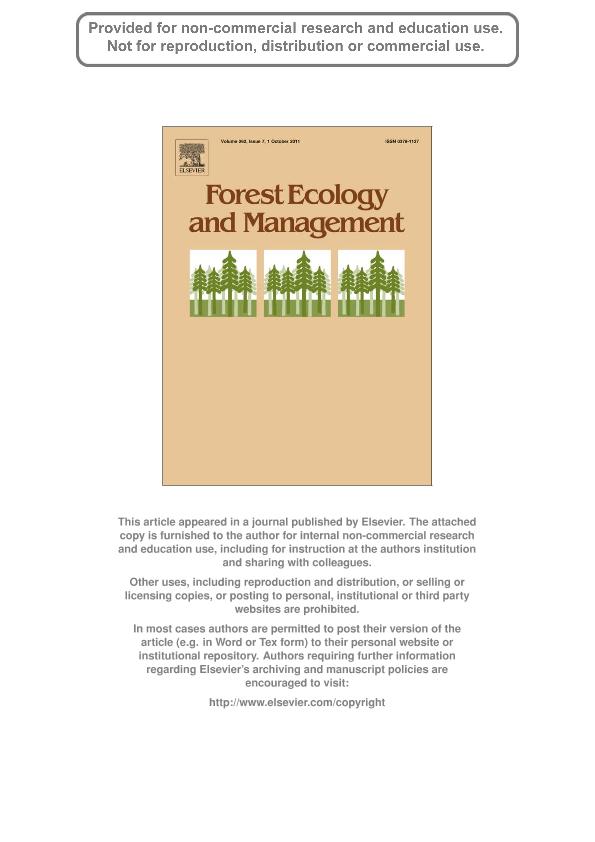Artículo
Alternative silvicultural practices with variable retention to improve understory plant diversity conservation in southern Patagonian forests
Lencinas, María Vanessa ; Martínez Pastur, Guillermo José
; Martínez Pastur, Guillermo José ; Gallo, Emilce Andrea; Cellini, Juan Manuel
; Gallo, Emilce Andrea; Cellini, Juan Manuel
 ; Martínez Pastur, Guillermo José
; Martínez Pastur, Guillermo José ; Gallo, Emilce Andrea; Cellini, Juan Manuel
; Gallo, Emilce Andrea; Cellini, Juan Manuel
Fecha de publicación:
10/2011
Editorial:
Elsevier Science
Revista:
Forest Ecology and Management
ISSN:
0378-1127
Idioma:
Inglés
Tipo de recurso:
Artículo publicado
Clasificación temática:
Resumen
Understory plants could can act as indicators of temperate forest sustainability, health and conservation status due to their importance in ecosystem function. Harvesting impacts on understory plant diversity depends on their intensity. Variable retention has been proposed to mitigate the harmful effects of timber harvesting, but its effectiveness remains unknown in southern Patagonian Nothofagus pumilio forests. The objectives of this study were to: (i) define a baseline of understory plant diversity in old-growth forests along a site quality gradient and under canopy gaps; (ii) evaluate stands with three different variable retention treatments compared to old-growth forests; and (iii) assess temporal changes during 4years after harvesting (YAH). A 61ha N. pumilio forest was selected. Understory plant (Dicotyledonae, Monocotyledonae and Pteridophyta) richness, cover (including woody debris and bare forest floor) and aboveground dry biomass were characterized in summer for 5years. Before harvesting, baseline samples were conducted along a site quality gradient and outside/inside canopy gaps. Analyzed treatments include a control of old-growth forest (OGF) and three different harvesting treatments with variable retention: (i) dispersed retention (DR) of 30m2ha-1 (20-30% retention); (ii) aggregated retention (AR) with one aggregate per hectare and clear-cuts (28% retention); and (iii) combined dispersed and aggregated retention (DAR) with one aggregate per hectare and dispersed retention of 10-15m2ha-1 (40-50% retention). Data analyses included parametric and permutational ANOVAs, multivariate classification and ordinations.Before harvesting, 31 plant species were found, where richness, cover and biomass were directly related to site quality. The presence of canopy gaps did not have a significant impact on the measured variables. After harvesting, 20 new species appeared from adjacent associated environments (two from N. antarctica forests and 18 from grasslands and peatlands). At the stand level, understory values were higher in AR > DR > DAR > OGF. Most (81-95%) plant richness at baseline conditions was conserved in all treatments, where inside the aggregates understory remained similar to OGF. Combination of aggregated and dispersed retention (DAR) better limited exotic species introduction and protected sensitive species, improving conservation in harvested stands. Changes in understory variables were observed after the first YAH in all treatments; greater changes were observed in the harvested areas than in aggregates. Changes stabilized at the fourth YAH. As a conclusion, the location of retention aggregates should be selected to preserve species understory diversity of more speciose and diverse habitats or particularly uncommon stands. Implementation of different kinds (patterns and levels) of retention for improvement of biodiversity conservation in harvested forests should be included in timber and forest management planning.
Archivos asociados
Licencia
Identificadores
Colecciones
Articulos(CADIC)
Articulos de CENTRO AUSTRAL DE INVESTIGACIONES CIENTIFICAS
Articulos de CENTRO AUSTRAL DE INVESTIGACIONES CIENTIFICAS
Citación
Lencinas, María Vanessa; Martínez Pastur, Guillermo José; Gallo, Emilce Andrea; Cellini, Juan Manuel; Alternative silvicultural practices with variable retention to improve understory plant diversity conservation in southern Patagonian forests; Elsevier Science; Forest Ecology and Management; 262; 7; 10-2011; 1236-1250
Compartir
Altmétricas



